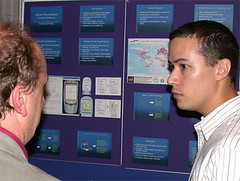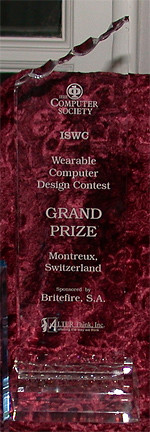A couple of days ago I was a guest at IEEE’s annual International Symposium on Wearable Computing (ISWC), held this year in Montreux, Switzerland. I was there to judge entries for the annual ISWC Design Competition, and to award the check and prestigious IEEE trophy.
As the sponsor of this year’s competition, I chose to set a challenge that took the thinking away from designing ultra-expensive cyborgian machines for ultra-niche purposes and instead focused on designing ultra-cheap solutions for ultra-mass markets. I wanted to see if anyone could come up with a design for using already existing devices and infrastructures to facilitate education and training in developing countries where computers (and even electricity) are simply unavailable and where a month of web access costs typically more than the annual per capita income.
Though I did not say so in the brief, for some time I have been advocating the idea of using mobile phones (that most ubiquitous of wearable computers) and the extensive wireless phone infrastructures for core literacy and basic business education. While MIT and others are making great strides toward the $100 computer, that’s an idea whose usefulness is severely undermined by the difficulty of distributing the device and the general lack of electrical power or conventional internet access in those areas where such a machine might be most desirable. The cell phone, on the other hand, is everywhere already and it’s already connected.
Jose Gonzales explains his team's entry to Paul Lukowicz, ISWC Chair.
The winning entry was submitted by a team of graduate engineering students from Florida headed by Jose Gonzales, whose day-job is designing data-acquisition systems for aircraft in the US military. If a sign of true creative genius is the ability to dramatically reverse your perspective and still stay clear and focused, Jose is a very impressive intellect. I’d be a little concerned that I liked his design simply because it aligned rather well with my own vision, but the other judges concurred unanimously that the entry was streets ahead of the competitors. The conceptual technical design approach was well-researched, elegant, cheap, and pretty much ready to roll. Now we need the content, instructional design, a little political will, and some kind of sponsorship for both the development and the running of the phone-based learning service.
In essence, the design takes advantage of the ubiquity of GPRS (its coverage around the world is remarkably comprehensive) and its data rate of 115kbps, which is more than adequate for sending text and speech in various configurations. This is complemented by the ubiquity of devices – in places like Kebira in Kenya, more than 8 out of ten people have access to a mobile phone, though they may not have electricity or running water. Hand cranks can provide charges, or for a few cents people recharge their phones from someone running a small street-corner generator. Put your content through a free open-source Java tool that configures it so it will work and look good on any of more than 500 different phone models, and you are (at least in theory) ready to teach.
But what is the economic model? It should be possible, given the low entry cost, to get large corporations, NGOs, or even governments to front the cash for development of the content, and to subsidise the delivery. Large corporations have a vested interest in getting involved in such projects, in part because they believe in good corporate citizenship, and in part because it’s a great marketing opportunity. In fact I had a brief conversation with a Nokia representative after I had made the award announcement, and he was keen to take the discussion further. Watch this space
Tuesday, 13 February 2007
International Symposium on Wearable Computing
Posted by
Godfrey Parkin
at
13:53
![]()
Subscribe to:
Post Comments (Atom)





No comments:
Post a Comment